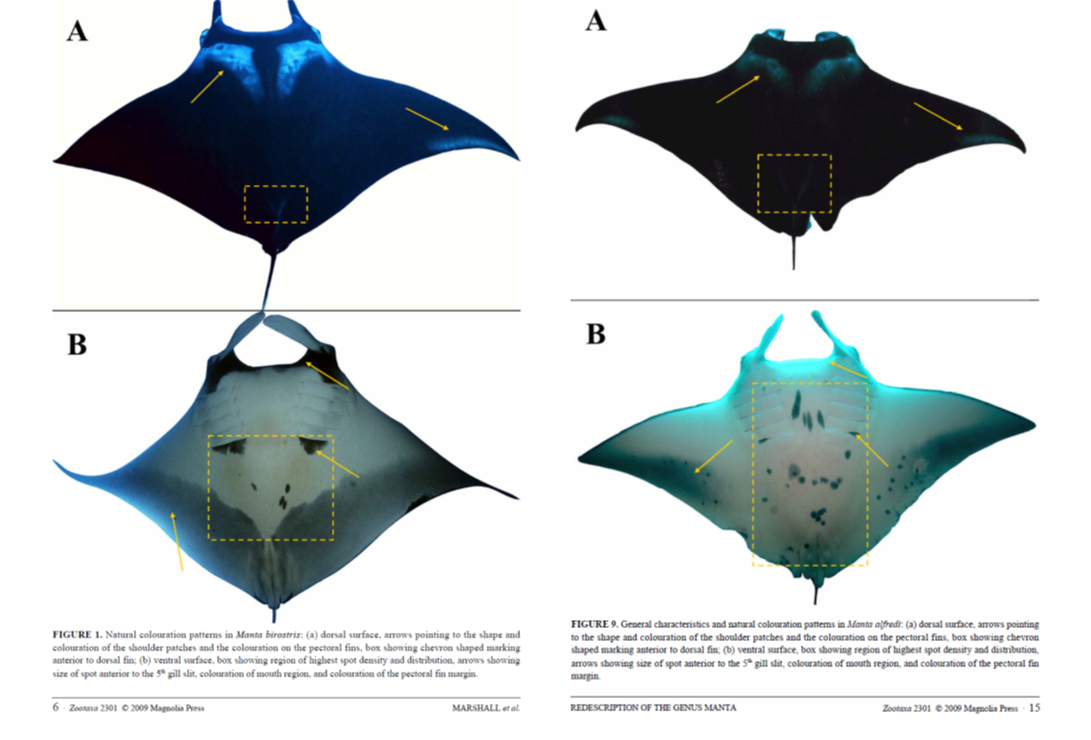

Gestation period for a female ray is around 13 months long and they only give birth to one or two young. Manta rays are ovoviviparous, so the baby stingray grows inside an egg within its mother and then is born completely developed.

Generally, female rays tend to be larger than males and can only be classified if you’re close enough to notice scarring on the back ventral side or fin tips, a sign that the ray is female and has mated with a male ray. Unlike stingrays, manta rays do not possess a “stinger ” they have a harmless, slender tail. In both groups, their mouths are located at the front of their bodies and they possess cephalic or “head” fins which enable them to funnel food and water more easily. Rays under alfredi are generally smaller, reaching a maximum wingspan of 18 feet, and can easily be identified by their big, blotchy spot patterns located on their ventral side. Rays under birostris have few spots on their ventral side, with wide, gray bands along the back edge of the wings and can reach a wingspan up to 23 feet. Manta rays have countershading coloration, meaning they are dark on top (the dorsal side) and light on the bottom (ventral side). These two groups are extremely similar in looks and behavior, but you can tell them apart by their coloration and markings. Manta rays are classified into two different species groups, the birostris and alfredi. There are major differences, however, that can enable you to identify a manta ray from a stingray. Their eyes are located on their dorsal (top) side, and they have a long, eerie tail. They both have pectoral fins that have developed into wide, triangular wings, enabling them to glide easily through the water. Both manta rays and stingrays are related to sharks under the cartilaginous fish group chondrichthyes, meaning their structure is built on material similar to that found in our nose and ears. However, stingrays are bottom feeders that eat various different species of crustaceans and mollusks.Let’s face it, manta rays and stingrays look pretty similar and you can only spot the differences if you know what you’re looking for. Diet: Manta rays are filter feeders, that feed exclusively on Zooplankton in the water column. However, most stingrays do not visit cleaning stations.Ĩ. Visitations to cleaning stations: Manta rays frequently visit cleaning stations in order to get their gills cleaned, and their parasites removed by cleaner fish. Cephalic fins: Manta rays possess a pair of cephalic ‘horn-like fins on their head, however, stingrays do not have these, instead of having just a continuous rounded head.ħ.

Place in the water column: Manta rays are exclusively pelagic, while stingrays are generally demersal, preferring to dwell on the bottom of the ocean floorĦ. They are generally much smaller in size and are proportionately much longer in length than they are wide.ĥ. Size: Manta rays are much larger in size, and are proportionately much wider than they are long. Mouth location: The mouth of a Manta ray is located on the front, forward-facing edge of the body, while the mouth of a stingray is located on the underside of its body.Ĥ. Habitat: Manta rays live predominantly in tropical and subtropical salt waters, while stingrays can also be found in warm temperate waters, as well as some species living in freshwater habitats.ģ.


 0 kommentar(er)
0 kommentar(er)
